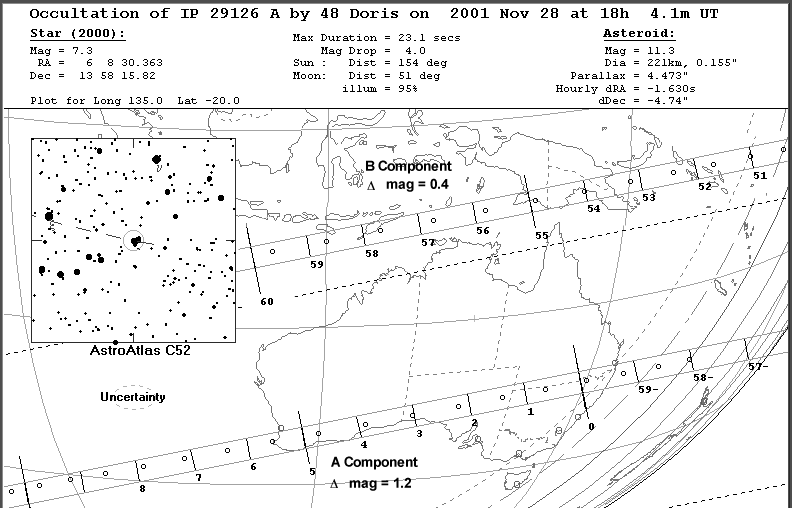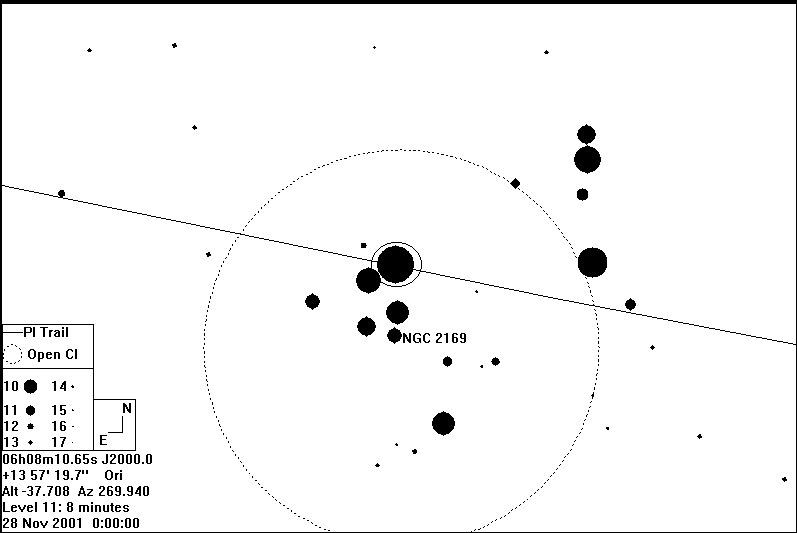ASTROMETRIC UPDATE:
OCCULTATION BY (48) DORIS - 2001 NOVEMBER 28
[Prediction by Edwin Goffin]
[Prediction using OCCULT software]
The prediction given by Goffin runs from the nothern New South Wales coast west across the head of the Great Australian Bight to the far southern coast of Western Australia. The path given by Occult lies a fraction of a path width to the north.
UPDATE: 22 November 2001
THE UPDATED PATH

The target star is in fact a close double (F.G.W. Struve 848) and the brightest star within the open cluster NGC 2169. The pair is relatively close at 2.6" and a P.A. of 110o. This produces two occultation paths as shown in the above diagram. The delta mag values given are for the combined system and if the stars can be seperately monitored, much larger values will apply.
The inner sections of NGC 2169 is poorly shown on the printed predictions by Edwin Goffin due to the scale used. Below is a plot out of Guide 7 showing the inner regions with the target star marked.

This updated path for the primary component lies around half a path width to the north of that given by Goffin and around a minute later. The path runs along the Queensland/New South Wales border covering the country between Brisbane city and Grafton at 17:59 UT. Further west, the path crosses central South Australia including Woomera and Coober Pedy around 18:02 UT. Further west the path covers all of the southern most sections of Western Australia including the southern Perth metropolitan areas around 18:05 UT.
The error margin easily draws in all of Brisbane (17:59 UT) and Perth (18:05 UT) along with Broken Hill (18:01 UT) with Adelaide as an outside chance at 18:02 UT.
The secondary path may be visible photometrically or visually if sufficient magnification is used and seeing permits seperately monitor the two stars in the system. This path crosses Papua New Guinea including Lae around 17:53:30 UT.
Calculation Source
This prediction update has been computed by Steve Preston, Medina (Seattle), Washington, USA based on astrometry from Ron Stone of the US Naval Observatory - Flagstaff Station, Bill Owen of Table Mountain Observatory - JPL, Gordon Garradd or Loomberah, New South Wales, Australia supplemented with data from the AstDys database. The Hipparcos position of the target star has been used.
EVENT DETAILS SUMMARY:
- Date and approx. UT time of event: 2001 November 28 - 18:00 UT
- Magnitude of target star: 7.3
- Magnitude drop [mag]: 1.2 (Primary - see above)
- Estimated maximum duration [s]: 23.1
- Angular distance to moon, phase of moon [deg,%]: 51, 95%
- Goffin's original chart reference: A01_1107
The Occultation Path:
- Approximate width [km]: 324
- Uncertainty [path widths]: +/- 0.25 (1 sigma)
- Remarks: Uncertainities are given on the basis of the nominal star position errors and the expected asteroid positional accuracy.
- Circles along the path are OCCULT calculated exact centerline points !!!!
Data for the target star:
- Name: TYC HIP 29126 = PPM 121967 = SAO 95282 = F.G.W. Struve 282
- Constellation: Orion
- J2000 position [h,m,s; o,',"]: 6h 08m 30.3633; +13o 58' 15.819"
- Position source: Hipparcos
- Estimated accuracy ["]: 0.027" (0.023", 0.014")
- V mag [mag]: 7.3 (Primary)
- Remarks:
- The target star is in northeast Orion. It is the brightest star within the open cluster NGC 2169 and lies 50 minutes of arc southwest of xi Orionis (magnitude = 4.5).
Data for the minor planet:
- Number, name: (48) Doris
- Approx. diameter [km]: 221
- Source of used astrometry: USNO - Flagstaff Station (Ron Stone), TMO (Bill Owen), Gordon Garradd, AstDys
- Number of used observations: 707
- Number of rejected observations: 90
- Time covered by the observations: 1906 07 16 - 2001 11 11
- Update computed by: Steve Preston, Medina, Washington, USA (Orbfit).
IMPORTANT NOTE!
Astrometric updates such as these should not be taken as definitive, but rather only as an indication of where the true track may lie relative to the original predicted track. Observers must bear in mind that later astrometry, in which the target star is measured in the same field as the asteroid, may still reveal substantial changes to the predicted track and time of the event. For this reason it is most important that observers far from the predicted track still monitor the event.
Use these links for further information:
[Planetary Occultations]
[Using the Predictions]
[Observing Details]
[Timing Details]
[Reporting Details]
[Report Form]
[Asteroid Occultation Results]
This page may have been updated since 22 November 2001.
Hit your browser's RELOAD button to get the latest version.
[Site Map]
[What's an Occultation?]
[Total Occultations]
[Grazing Occultations]
[Planetary Occultations]
[Jovian Satellite Eclipses]
[Timing Occultations]
[Reporting Observations]
[Coming Events]
[Software]
[About Us]
[Publications]
[Membership]
[Links]
[Top of Page][Return to Home Page]

